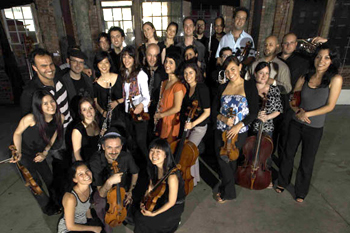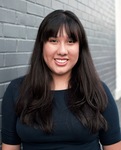In a happy return to live performance following the lengthy Covid-19 suspension, Chamber Music Wilmington opened its 2021-22 season with a concert by the Merz Trio. The pleasure of returning to live music making was matched by the artistry of this superb young group.
Chamber Music Wilmington has made a substantial mark in the Port City by presenting ensembles of the highest quality. Beckwith Recital Hall, the locale of this concert on the campus of the University of North Carolina Wilmington, matched the quality of the performance with its superb acoustics and perfect size for chamber music. Every nuance, no matter how soft, is projected to the audience there.
The Merz Trio has won several performance prizes, including at the prestigious Fischoff Competition. It was announced from the stage that they were very recently prizewinners in the Naumburg Competition, an event of international stature. The Merz Trio’s members are Brigid Coleridge, violin, Julia Yang, cello, and Lee Dionne, piano.
The first work on their program was River Songs, written in 2014 by the American composer Chris Rogerson. Rogerson studied at Yale, Princeton, and the Curtis Institute; at Curtis he is now a faculty member. His works have been performed by major orchestras such as the San Francisco Symphony and the Atlanta Symphony. Distinguished soloists such as Ida Kavafian and David Shifrin have played his music.
River Songs, a substantial three-movement piece has, according to the program notes, an autobiographical quality. It was “inspired by youthful family vacations to a remote lake in Washington State.” Like the prevailing style of composition today, it is fundamentally tonal. But tonality has proven itself capable of almost endless imaginative permutations, as this evocative piece amply shows.
The first movement “A Fish Will Rise” (based, we were told from the stage, on the composer’s sister’s dogged determination to catch a fish), centers a good deal around the pitch A. There are hints of fiddle music, and a dynamic climax is followed by an abrupt cut back to soft. Rich, flowing sounds are pictorial of the water and lovely softs give the movement a meditative quality.
“Clouds,” the second movement, is more agitated, with a skittering quality; one could see the clouds sliding across the sky propelled by the wind. There are beautiful changes of color and an ending coming to a fine fade on a single note. The final movement, “Swan Song,” evokes “an old man fishing the waters alone among the shadows.” It is meditative, as one might expect, but not sad. The violin stood out here with excellent high-range playing at the beginning. The cello then took over with its lush, dark quality. A crescendo in both instruments was accompanied by full supporting chords in the piano. The climax was passionate, yet retained the meditative quality. The piano then had sensitive unisons. This spare passage was an example of how much can be done with just a little.
The entire piece impressed with its lyrical expression. Meditative character turned out to be a signature quality of the ensemble, which created a synergy between music and performers. One was also impressed by the fact that this piece, written just a few years ago, came over not as “new music” aspiring to find its place, but simply as excellent music fully at home on a program which also included Haydn and Brahms.
The following Haydn Trio in E, Hob. XV:28, was of the good humor and fresh invention which so characterize Haydn. The opening with pizzicato lent it an attractively unusual quality. The development was sparkling, with a pleasing cadenza at the end. The return had a beautiful pp in the piano. Throughout the movement, one was impressed by the always-clean articulation in the piano, the finely shaped, matched phrasing of all the instruments, and the sense of complete communication among the three players.
The second movement is in a thoughtful minor mode and is rather unusual stylistically. It is redolent of Baroque sound, with the piano bass acting much as a continuo supporting a long melody. Here one wondered whether the piano needed to have as much of a percussive quality as it sometimes did. There was an excellent flourish in the piano at the end which led without pause to the sparkling third movement. Its light, good spirits also has a counterpart in an agitated minor mode section. Haydn had great capacity for drama, as this section aptly shows. After this, the violin had a wonderful fade on a trill, which then led via a perfectly-timed fermata back to the main theme. The ending was delightfully humorous.
After the intermission the program was devoted entirely to Brahms’ massive Trio No. 1 in B, Op. 8. It was played here in the almost universally-heard revision of 1889, made thirty-five years after it was first written. This trio is one of the crowning works of the chamber literature, and the performance realized every bit of its greatness.
This is a piece which grants great visibility to the cello, and the cellist here often appeared transported in expressing the long phrases. Overall, the performance of the first movement emphasized its thoughtful, expressive quality over its drama. In that way it carried an almost elegiac quality, so familiar in the style of late Brahms. The passagework in the piano was always beautifully articulated. One could make an argument for the use of more pedal in this very lush music, but the long line of the phrasing compensated for that.
The darker second movement has a spectral quality. The challenging technical figures were produced with utmost clarity. The magnificent climax of the trio section, yet again, was more lyrical and expressive than dramatic. The strings, by not playing too loud, gave the piano space to carry that expressivity. The return to the darkness of the main theme was beautifully done.
The third movement, with the material introduced by the piano, carried an atmosphere of timeless reflection. The strings created their own beautiful tracery around that. A standout moment was the pianissimo at the end of the first section, followed by a gorgeous rendition of the theme in the cello, finely supported by the piano. The whole movement had the effect of a single, unbroken arc.
The dark last movement was again very articulated in the piano. This movement became the climax of the whole trio with its powerful high points. This time it was the violinist’s turn to seem transported in melodic expression. The always-stunning ending was reached via dark anticipation, and the unleashing of the peroration was greeted by a well-deserved ovation from the audience.
After such powerful expression, the group played a short, lyrical encore: their own arrangement of the song “Widmung” (Dedication) by Robert Schumann. It was an appropriate ending: Schumann wrote this song in his year of passionate effusion after his hard-won marriage to Clara. And Schumann, the great supporter of Brahms, was playing host to Brahms when the latter wrote the first version of the great trio just heard.
This was an arrangement which, if possible, seemed to add depth to the glorious original. By having a dialogue between violin and cello, the song became a love duet – a different but equally strong expression of its sentiment. At the end there were flourishes in the piano which allowed it to emerge from an accompanying role. One could question whether this added to or took away from the intimacy of the song. Either way, it was a beautiful ending to a program of the highest artistic quality.












